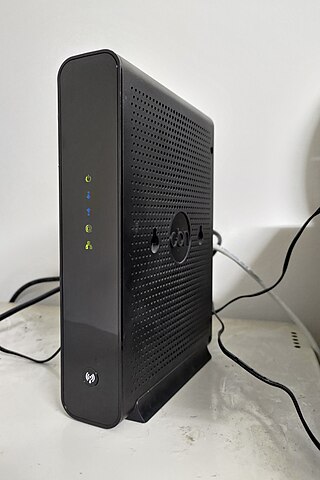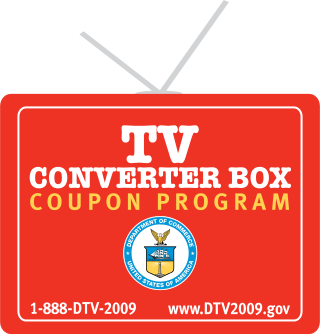
Cable television is a system of delivering television programming to consumers via radio frequency (RF) signals transmitted through coaxial cables, or in more recent systems, light pulses through fibre-optic cables. This contrasts with broadcast television, in which the television signal is transmitted over-the-air by radio waves and received by a television antenna, or satellite television, in which the television signal is transmitted over-the-air by radio waves from a communications satellite and received by a satellite dish on the roof. FM radio programming, high-speed Internet, telephone services, and similar non-television services may also be provided through these cables. Analog television was standard in the 20th century, but since the 2000s, cable systems have been upgraded to digital cable operation.

A set-top box (STB), also known as a cable box, receiver, or simply box, and historically television decoder or a converter, is an information appliance device that generally contains a TV tuner input and displays output to a television set, turning the source signal into content in a form that can then be displayed on the television screen or other display device. It is designed to be placed alongside or "on top" of a television set.
In telecommunications, a scrambler is a device that transposes or inverts signals or otherwise encodes a message at the sender's side to make the message unintelligible at a receiver not equipped with an appropriately set descrambling device. Whereas encryption usually refers to operations carried out in the digital domain, scrambling usually refers to operations carried out in the analog domain. Scrambling is accomplished by the addition of components to the original signal or the changing of some important component of the original signal in order to make extraction of the original signal difficult. Examples of the latter might include removing or changing vertical or horizontal sync pulses in television signals; televisions will not be able to display a picture from such a signal. Some modern scramblers are actually encryption devices, the name remaining due to the similarities in use, as opposed to internal operation.

A cable modem is a type of network bridge that provides bi-directional data communication via radio frequency channels on a hybrid fiber-coaxial (HFC), radio frequency over glass (RFoG) and coaxial cable infrastructure. Cable modems are primarily used to deliver broadband Internet access in the form of cable Internet, taking advantage of the high bandwidth of a HFC and RFoG network. They are commonly deployed in the Americas, Asia, Australia, and Europe.

An RF modulator is an electronic device used to convert signals from devices such as media players, VCRs and game consoles to a format that can be handled by a device designed to receive a modulated RF input, such as a radio or television receiver. Its input is a baseband signal, which is used to modulate a radio frequency source.
Digital cable is the distribution of cable television using digital data and video compression. The technology was first developed by General Instrument. By 2000, most cable companies offered digital features, eventually replacing their previous analog-based cable by the mid 2010s. During the late 2000s, broadcast television converted to the digital HDTV standard, which was incompatible with existing analog cable systems.

A cable television headend is a master facility for receiving television signals for processing and distribution over a cable television system. A headend facility may be staffed or unstaffed and is typically surrounded by some type of security fencing. The building is typically sturdy and purpose-built to provide security, cooling, and easy access for the electronic equipment used to receive and re-transmit video over the local cable infrastructure. One can also find head ends in power-line communication (PLC) substations and Internet communications networks.
Hybrid fiber-coaxial (HFC) is a broadband telecommunications network that combines optical fiber and coaxial cable. It has been commonly employed globally by cable television operators since the early 1990s.
Television encryption, often referred to as scrambling, is encryption used to control access to pay television services, usually cable, satellite, or Internet Protocol television (IPTV) services.
Cable-ready is a designation which indicates that a TV set or other television-receiving device is capable of receiving cable TV without a set-top box.
Cable television first became available in the United States in 1948. By 1989, 53 million U.S. households received cable television subscriptions, with 60 percent of all U.S. households doing so in 1992. Most cable viewers in the U.S. reside in the suburbs and tend to be middle class; cable television is less common in low income, urban, and rural areas.

Satellite television is a service that delivers television programming to viewers by relaying it from a communications satellite orbiting the Earth directly to the viewer's location. The signals are received via an outdoor parabolic antenna commonly referred to as a satellite dish and a low-noise block downconverter.

A digital television adapter (DTA), commonly known as a converter box or decoder box, is a television tuner that receives a digital television (DTV) transmission, and converts the digital signal into an analog signal that can be received and displayed on an analog television set. Some also have an HDMI output since some TVs with HDMI do not have a digital tuner. The input digital signal may be over-the-air terrestrial television signals received by a television antenna, or signals from a digital cable system. It normally does not refer to satellite TV, which has always required a set-top box either to operate the big satellite dish, or to be the integrated receiver/decoder (IRD) in the case of direct-broadcast satellites (DBS).

A coupon-eligible converter box (CECB) was a digital television adapter that met eligibility specifications for subsidy "coupons" from the United States government. The subsidy program was enacted to provide terrestrial television viewers with an affordable way to continue receiving free digital terrestrial television services after the nation's television service transitioned to digital transmission and analog transmissions ceased. The specification was developed by the National Telecommunications and Information Administration (NTIA), with input from the broadcast and consumer electronics industries as well as public interest groups.
TrueVisions is the largest provider of a cable analog television (CAtv) and digital satellite television (DStv) in Thailand. TrueVisions is a subsidiary of the business division of True Corporation.
Cable television piracy is the act of obtaining unauthorized access to cable television services. It is a form of copyright infringement and a federal crime. Reception of cable television without authorization by a cable operator is forbidden by both federal and state laws. In Missouri, cable television piracy is usually a class A misdemeanor; if the service is $500 or more, it is classified as a class C felony.
Addressability is the ability of a digital device to individually respond to a message sent to many similar devices. Examples include pagers, mobile phones and set-top boxes for pay TV. Computer networks are also addressable via the MAC address on Ethernet network cards, and similar networking protocols like Bluetooth. This allows data to be sent in cases where it is impractical to control exactly where or to which devices the message is physically sent.
When a descrambler is added to the Cable Converter Box in the same chassis, it is referred to as a Converter/Descrambler or sometimes a Combination Unit, and is a type of Set-top box, it allows : local broadcast channels, basic cable channels, authorized premium channels, "Pay-Per-View" (PPV), and “Video On Demand” (VOD) services to be viewed. A Combination Converter/Descrambler is generally called a Set-top box or STB it is a single (one-piece) system installed in a single cabinet and represents a single component that is capable of descrambling premium services, like HBO or Showtime, pay-per-view cable channels., Video on Demand, Games or other specialty pay services, and transposes the cable signal for RF output on channel 3 or 4. This unit contains a converter and a descrambler, enclosed in a common box and outputs the signal directly to a TV, VCR, DVR, PC, DVD or video projector.
Analog passthrough is a feature found on some digital-to-analog television converter boxes. Boxes without the analog passthrough feature only allow older, analog-only TVs to view digital TV. Those with analog pass-through allow both digital and analog television to be viewed on older TVs.
Full Channel, Inc. was an American pay television and telecommunications provider set in Rhode Island. At the time of its acquisition by CountryWide Broadband it was the third-largest cable television and Internet service provider in the state. Its wired communications network was available to the approximately 50,000 residents of Bristol County, Rhode Island. Full Channel's main office was at 57 Everett Street in Warren, Rhode Island, U.S.








